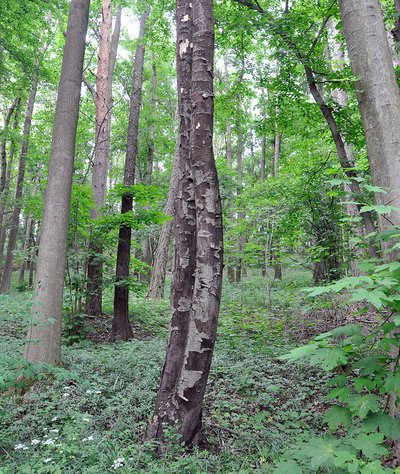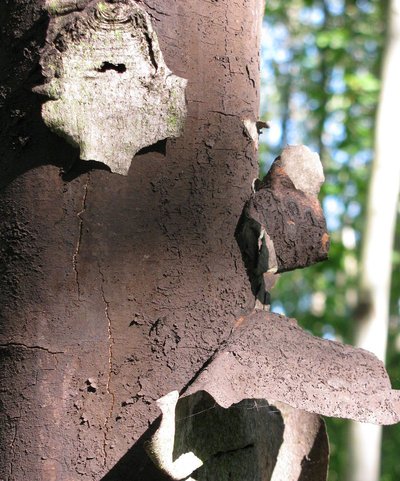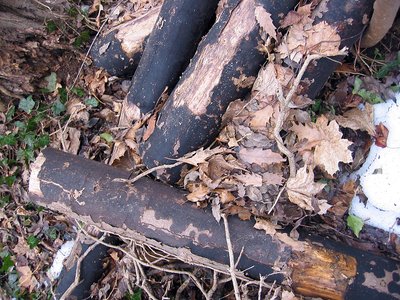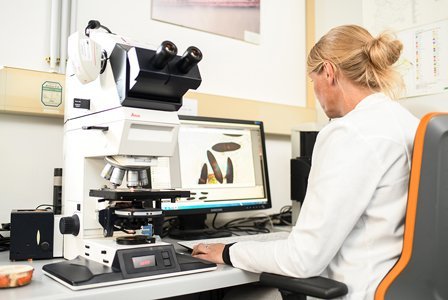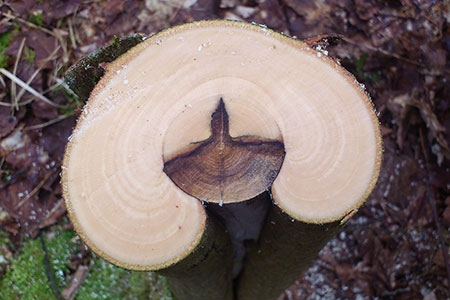In June and July of 2018, the Bavarian State Institute of Forestry (LWF) received three reports of sickened maple trees that displayed the characteristic pattern of damage of the sooty bark disease. The phytopathalogical investigations confirmed the pathogen Cryptostroma corticale. As a result, the first confirmed infestation with the sooty bark disease in Bavaria was found.
Biology and distribution
C. corticale is described as a saprophytic parasite of maples. It can survive for a long time as an endophyte under the bark without showing signs of infestation in its hosts. If the host becomes weakened due to stress, the fungus will produce fruiting bodies on the dying wood.
Small wounds on the tree serve as a portal of entry for the fungus. First it spreads in the xylem and later in the phloem and produces a dark, flat mesh of hyphae under the bark. The plentiful soot-like spores (up to 170 million per cm2) can build up to a one centimetre thick coating on the trunk which can be spread by the wind or washed away by rain.
In Europe the sycamore maple is the first host tree which is affected, less often the Norway maple, common maple and silver maple; the main host tree in North America is the sugar maple. Every age class can be infested by C. corticale.
The sooty bark disease was first discovered in Europe in 1945 on a sycamore maple in Great Britain. After the dry spell in 2003 a number of first discoveries were reported in Switzerland, Austria, the Czech Republic and France. Thereafter followed reports in the Netherlands (2013), Bulgaria (2014) and Italy (2016). In Germany, the sooty bark disease was first discovered in 2005 in Karlsruhe. Isolated findings in various federal states soon followed. Currently, the wind distributed spores have reached the warm areas of Bavaria.
The catalyst and symptoms
The extreme warmth loving bark fungus profits from exceptionally long summers with drought stress, lack of water and extreme heat. It only becomes prominent when the average monthly temperature in June, July or August is greater than twenty-three degrees. Additional stress factors such as high NOx emissions, temporary flooding or adverse site conditions may favour its occurrence.
The appearance of C. corticale becomes very characteristic if it becomes malignant. In the beginning of the infestation considerable defoliation and wilting symptoms occur in the top of the crown and progresses downward. Later, longitudinally orientated cracks in the bark with mucus flows and necrosis appear, which in turn combine to form large, dead bark flakes (Fig. 1). Infested trees can die within a year if the fungus is highly virulent.
The thick layers of black fungal spores under the peeling bark are conspicuous and the trunks appear as if they are covered in soot (Fig. 2). Rain and wind distribute the spores to the root collar and onto the surrounding vegetation.
Maple trees which were alive at the time of felling show in their cross-section a greenish, yellowish or brownish discoloration in the wood. The wood is quickly decomposed by secondary penetrating white rot fungi which can lead to the breakage of the trunk.
Recommendations for the praxis
The majority of the findings of the fungus has been located in urban areas in which the trees have been exposed to major climatic extremes and heavy traffic emissions. However, C. corticale has also been found in forest stands.
All preventative measures in urban green spaces serve to avoid stress. A possible infestation should be confirmed microscopically since other saprophytic fungus produce black fruiting bodies under the bark. In the case of a confirmed infestation the area of infestation should be closed off on a wide scale and diseased trees should be felled immediately in compliance with the recommendations pertaining to the protection of health.
Infested wood should be transported in covered containers during delivery to an incinerator (e.g. a combined heat and power plant). Chipping the wood or using it as fire wood is not possible. Infestations must be reported to the local municipality and forestry agency.
Health protection
The spores play an important role for human health since they can cause inflammation in the alveoli when inhaled (exogenous allergic alveolitis). Typical symptoms usually occur six to eight hours after contact and encompass dry coughs, fever, fatigue, chills and even respiratory distress.
As a result, full personal protective equipment consisting of goggles, fine dust masks (FFP3), overalls, protective gloves and boots are necessary for all work on infested trees. During the felling operations damp weather is preferred in order to keep the contact with the spores to a minimum.
Outlook
Maple species play a significant role as urban trees due to their high resistance to emissions. The sooty bark disease infests maples and sooner or later will cause the death of the trees. The pathogen C. corticale has been spreading continuously since 1945 and has now reached Bavaria. However, the disease only occurs sporadically and, unlike ash dieback, it seems to pose no fundamental risk for the survival of maple species in central Europe.

